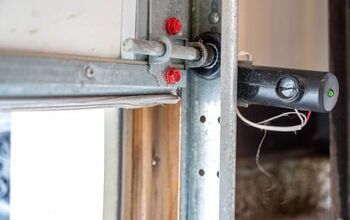Will A Garage Door Work Without the Sensors?

If you have a garage door opener, you may already have experienced the frustration of a garage door that will not open or will not close. Bad or misaligned sensors are usually the culprit for this problem. You must wonder then if there is a way to bypass them and make the garage door work without the sensors?
A garage door will not automatically open and close if your sensor is damaged or not working. You can still open and close the garage door manually if you have a bad sensor. Check to make sure that nothing blocks the sensor because it will not work properly.
Manually operating your garage door is not difficult, nor is it dangerous. Since the 1990’s Federal law has mandated that garage door openers have a safety sensor. These sensors prevent the door from closing on a person or animal and causing injury or death. (For more information about the federal mandate, you can see the standards here.)
Do You Need a Garage Door Repair Service?
Get free, zero-commitment quotes from pro contractors near you.

Manually Opening and Closing Your Garage Door
Garage door manufacturers anticipate failures. Every garage door opener has a manual release that allows you to raise and lower your garage door. It is an easy process to activate the emergency release and raise or lower your garage door.
Step One: Secure the Garage Door
If your garage door is in the down position, you are good to go. If the garage door is in the up position, for safety reasons, you should prop the door up. 2×4’s are perfect for this. Place a 2×4 on each side of the garage door and wedge it against the bottom edge of the door.
Step Two: Pull the Emergency Release Cord
Pull the emergency release cord attached to the trolley on the garage door opener rail. Pulling the cord should release the door from the opener. Take care that the arm attached to the garage door doesn’t swing down suddenly.
Note: If the arm connecting the door to the trolley doesn’t slip-free, you may need to raise the door slightly to allow the arm to come free of the trolley connection.
Step Four: Check Tension
If the garage door is in the open position, look at the springs and make sure that the tension looks the same. If everything on the springs and cables looks normal, then it is time to lower the door.
Step Five: Remove Props with Assistance
With help from another person, remove the 2×4 props on each side of the door. One person should hold the door up while the second person removes the props. Be careful with this step. A problem with the mechanism or springs will put the entire weight of the door on the props.
Step Six: Lower the Garage Door
Carefully lower the garage door to the fully closed position. Again, examine all the hinges, rollers, springs, and cables. If nothing appears amiss, try raising the garage door manually. If you can raise the door and lower it again, everything is operating normally.
How Do Garage Door Safety Sensors Work?
The safety sensors used as protection against accidental entrapment use photo-cell technology. Photocells are proven technology that has many uses in industry. The concept is simple yet exceptionally reliable.
A photocell is placed about two inches above the floor on one side of the garage door. A second unit on the opposite side of the doo contains the sending unit with an infra-red emitter
Regular Operation – An Uninterrupted Beam
If the infra-red beam is visible to the photocell, the garage door will operate normally. Typically, the photocell receptor has an indicator on the housing. A red light indicates that the photocell doesn’t see the infrared beam. A green light indicates that everything is operating normally.
The problem may not be your safety sensors at all. A stuck garage door or one that binds may be the issue. For more information about garage doors that won’t close, check out this article.
When Things Don’t’ Work – The Interrupted Beam
There are several reasons why a safety sensor may not operate. Some of the more common issues include:
- A misaligned sensor
- Something blocking the sensor
- A dirty or damaged photocell
- A broken wire or faulty connection
What Color Should the Lights Be on Garage Door Sensors?
The photo eyes on your garage door sensors will usually have one receiver eye and one emitter eye. The latter sends out the beam, while the former senses it. Regardless of the manufacturer, garage door sensors will have color LEDS to indicate operation. These colors will help you determine when there is a problem with one or both of your sensors.
The colors that your garage door sensors should be will vary based on the manufacturer:
- Chamberlain, Liftmaster, and Craftsman: The transmitter LED should display yellow or amber, and always be lit. Whereas, the receiver LED should be brightly lit green.
- Genie and Overhead: The transmitting eye should always be lit a solid red and the receiving eye will be solid red if it is receiving the signal and everything is operating normally. If it is turned off or blinking, there is an issue.
- Marantec: When the sensors are aligned correctly, there will be a solid green light on the transmitter sensor and a sold red light on the receiver sensor.
- Guardian: When the system is working properly, the transmitter LED will emit a steady, solid green light. Proper alignment will be indicated by a steady, solid red light coming from the receiver LED.
Diagnosing a Problem with the Safety Sensors
Sometimes finding the problem is as simple as taking a closer look at the sensors themselves. Often the problem is visible and is easily corrected. Here are some of the possible causes and fixes for malfunctioning garage door sensors:
1. Check for a Clear Path
Make sure nothing is interrupting the infrared beam. You might be surprised how small an object can interfere with the safety sensor. Look across the entire width of the garage door opening. Make sure nothing is between the photocell and the infrared emitter.
2. Misalignment issues
If the sensors seem to be out of alignment or the brackets are bent, the photocell may not see the infrared beam. With the door closed, look at the sensors on each side of the door. If they seem out of alignment, carefully readjust them.
It is easy to tell if you have the alignment right. When the photocell sees the infrared beam, the indicator light on the photocell will turn green. A green indicator light shows that the safety circuit is operating, and the garage door opener should operate normally.
3. The Environment Can Be an Issue
Garage door safety sensors live in a harsh environment. Often they will be subject to extremes in weather and temperature, abuse, and damage. A good look at your sensor may reveal the real problem.
The photocell can become dirty enough to fail to see the infrared beam. A wipe with a soft cloth can often solve all your problems. The same can happen to the small opening through which the infrared beam must pass from the emitter.
4. The Incomplete Circuit
If the wiring that connects the sensors with the motor unit of the garage door opener is exposed, it can be damaged easily. Inspect any exposed wiring for cuts or breaks. Many openers and sensors have screw connectors that can work loose. Check the connections and make sure that the circuits are complete.
Garage Door Sensor Repair Options
Unfortunately, when the issue can’t be easily corrected by cleaning or realigning the sensors, the sensors themselves are likely faulty, requiring a replacement. Otherwise, you’ll never be able to open or close your garage door remotely. For safety purposes, you should have this issue corrected as soon as possible.
Until the sensors are operating properly again, disconnect the unit entirely and use the garage door manually. It is crucial that the garage door is secured if a sensor happens to fail. Most doors with openers are not outfitted with manual locking devices.
If you’re especially handy, you may be able to replace the garage door opener yourself. You can purchase aftermarket openers at any of your local home improvement stores. Alternatively, professional installation is always an option if you don’t feel confident in your abilities.
Maybe It’s Not the Sensors?
If the garage door opener works from the main controller or the keypad, the problem may be the remote. Check out this article for more help with non-working sensors.
Are Garage Door Sensors Required?
Although garage door sensors are a very important and useful safety feature, you may be wondering if they’re optional. In short, no, you cannot decline installing garage door sensors anywhere in the United States.
Garage doors have been required by law since 1993 to be manufactured with a safety-reversing system, such as sensors. Technically speaking, there are other options that can fulfill this requirement, but garage door sensors are the most commonly used. Regardless, you are required to have some sort of approved safety device on your garage door.
Do You Need a Garage Door Repair Service?
Get free, zero-commitment quotes from pro contractors near you.

Final Thoughts
You can operate your garage door even if the sensors aren’t working. You may have to do a little manual labor in the process. Despite the frustrations, faulty sensor repair or replacement is easy and is well within the capability of most DIY’ers.

We are a team of passionate homeowners, home improvement pros, and DIY enthusiasts who enjoy sharing home improvement, housekeeping, decorating, and more with other homeowners! Whether you're looking for a step-by-step guide on fixing an appliance or the cost of installing a fence, we've here to help.
More by Upgraded Home Team



























